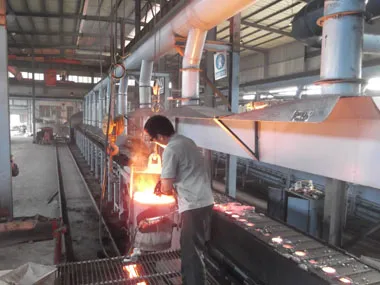Mobile:+86-311-808-126-83
Email:info@ydcastings.com
turbocharger turbine housing
Understanding the Turbocharger Turbine Housing An Essential Component of Forced Induction Systems
The turbocharger has become an integral component in modern automotive engineering, particularly for enhancing engine performance and efficiency. At the heart of this technology lies the turbine housing, which plays a critical role in the operation of a turbocharger. Understanding the turbine housing's structure, function, and significance can provide insights into how turbocharged engines maximize power output and fuel efficiency.
What is a Turbocharger?
Before diving into the specifics of the turbine housing, it’s essential to understand what a turbocharger is. Essentially, a turbocharger is a forced induction system that compresses air entering an engine, allowing it to burn more fuel and, consequently, produce more power. The turbocharger consists of two main components the turbine and the compressor. The turbine, driven by exhaust gases, is what propels the compressor side of the turbocharger, which draws in and compresses the intake air.
The Role of the Turbine Housing
The turbine housing is a crucial part of the turbocharger’s turbine assembly. It encases the turbine wheel and serves multiple functions
1. Guiding Exhaust Gases The turbine housing directs the flow of exhaust gases toward the turbine wheel. This is vital for maintaining optimal airflow and ensuring that the maximum amount of exhaust energy is harnessed to spin the turbine.
2. Pressure and Temperature Management The design of the turbine housing is engineered to withstand extreme temperatures and pressures generated by the exhaust gases. It is typically made from high-temperature resistant materials like cast iron or stainless steel, which can endure the intense environment of the engine's exhaust system.
3. Turbolag Reduction An efficient turbine housing design helps minimize lag— the delay before the turbocharger provides boost. By optimizing the shape and size of the housing, engineers can enhance the turbocharger's responsiveness, leading to better throttle response and acceleration.
turbocharger turbine housing

Design Variations
Turbocharger turbine housings can vary significantly in design, size, and shape, all of which affect their performance characteristics
. Here are some key factors that influence turbine housing design- A/R Ratio (Area/Radius Ratio) The A/R ratio is a crucial measurement that describes the geometry of the turbine housing. A smaller A/R ratio allows for quicker spool-up times and more immediate throttle response, as it channels exhaust gases more directly to the turbine. Conversely, a larger A/R ratio is typically better for high-end power and efficiency but may result in increased lag.
- Turbine Wheel Size The size of the turbine wheel itself also impacts how effectively the housing can convert exhaust energy into usable power. A larger turbine wheel can potentially generate more power at high engine speeds, but it may lead to increased lag at lower speeds.
- Internal Features Some turbine housings incorporate internal features such as vanes or scroll designs that improve the efficiency of exhaust gas flow and enhance overall performance.
Importance in Performance Tuning
For enthusiasts looking to extract optimal performance from turbocharged engines, the choice and modification of the turbine housing can be critical. Upgrading to a better-designed housing can lead to significant improvements in spool time and overall horsepower. Many aftermarket options provide tuners with the flexibility to select housings optimized for specific performance goals, whether that's improved low-end torque or top-end power.
Conclusion
The turbine housing is a fundamental component of turbocharging technology, significantly impacting an engine's performance characteristics. Its design, material selection, and geometry are crucial for optimizing the conversion of exhaust energy into usable power. As automotive technology continues to evolve, the importance of efficient, high-performance turbine housings will only grow, further enhancing the capabilities of turbocharged engines. For anyone interested in automotive engineering and performance enhancements, the study of turbocharger turbine housings offers a fascinating glimpse into the science of forced induction and the pursuit of power.
-
Why Should You Invest in Superior Pump Castings for Your Equipment?NewsJun.09,2025
-
Unlock Performance Potential with Stainless Impellers and Aluminum End CapsNewsJun.09,2025
-
Revolutionize Your Machinery with Superior Cast Iron and Aluminum ComponentsNewsJun.09,2025
-
Revolutionize Fluid Dynamics with Premium Pump ComponentsNewsJun.09,2025
-
Optimizing Industrial Systems with Essential Valve ComponentsNewsJun.09,2025
-
Elevate Grid Efficiency with High-Precision Power CastingsNewsJun.09,2025











